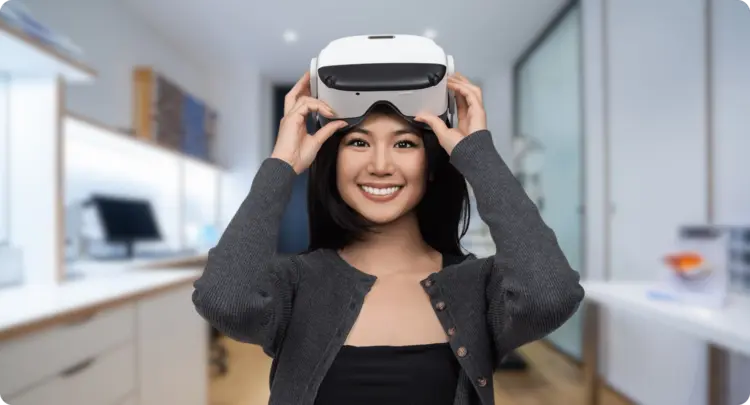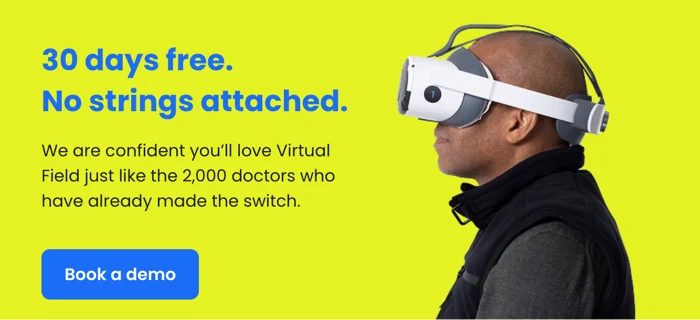Within the field of ophthalmology, achieving accurate and efficient visual field testing is paramount. Virtual Field addresses this need by offering a virtual reality testing experience designed to enhance patient care.
Since its introduction in 2018, Virtual Field has undergone continuous development, reflected in over 200 software updates to date. This commitment to innovation ensures that eye care professionals have access to a system that is both precise and user-friendly.
By leveraging Virtual Field's technology, thousands of providers across various specialties have successfully conducted millions of eye examinations. If you are looking to join this network of satisfied providers and experiencing an exceptional end-to-end eye exam firsthand, Virtual Field offers a complimentary 30-day trial.
Comparing Virtual Field and Humphrey Visual Field Testing
Reliable and accurate visual field testing is incredibly important. Eye care professionals use exam results to make critical diagnoses and patient treatment decisions. Here's how Virtual Field's visual field testing compares to the Humphrey Field Analyzer (HFA) and Humphrey Visual Field (HVF) 24-2 SITA testing, the current gold standard.
Multiple studies have demonstrated strong agreement between Virtual Field and Humphrey testing. Some examples include the Investigative Ophthalmology & Visual Science’s reports comparing VVF vs. HVF in an academic ophthalmic practice and VVF vs. HFA testing in glaucoma and optic nerve disease. Similarly, the American Society of Cataract and Refractive Surgery reported a comparison between VVF and HVF in a comprehensive ophthalmology practice.
These studies have shown comparable results in terms of mean deviation (MD), visual field index (VFI), and pattern standard (PSD). This indicates that Virtual Field delivers accuracy on par with the established Humphrey testing.
However, Virtual Field offers distinct advantages that enhance the patient experience and workflow efficiency.
- Cost Effectiveness: Virtual Field testing is significantly faster, typically taking just two to four minutes per eye compared to the Humphrey’s standard five to seven minutes. This translates to reduced patient chair time, which can potentially allow you to see more patients in a day and benefit your bottom line.
- Portability, Mobility and Accessibility: Virtual Field's visual field exam devices are designed for accessibility, ease of use and patient comfort. The immersive virtual environment eliminates the need for cumbersome headrests and chinrests, potentially reducing patient anxiety and improving accessibility, comfort and test reliability. The device’s design also aids in portability and mobility, as it can easily be maneuvered around the exam room. This can be especially advantageous for patients that can’t reasonably access the standard tabletop perimeter. The headset itself also offers audio instructions in 38 languages which enables non english speakers to test with ease.
- Efficiency: Virtual Field offers real-time feedback during testing, allowing you to adjust the examination as needed. The headset itself handles occlusion, so removing the need for an eye patch can result in more efficient exams. Additionally, the system automatically generates progression analysis reports after just two examinations on the same eye. This facilitates close monitoring of visual field changes over time, aiding in the detection and management of glaucoma and other eye diseases.
In conclusion, Virtual Field provides a compelling alternative to Humphrey visual field testing. It delivers comparable accuracy in a faster, more patient-friendly, and efficient manner, empowering you to deliver exceptional eye care to your patients.
Streamlining Visual Field Testing with Virtual Field’s BOLT Algorithm
Virtual Field's introduction of the BOLT algorithm in 2019 marked a significant advancement in eye care technology. As mentioned, this proprietary thresholding algorithm *reduces exam times by nearly half, taking a mere three to five minutes per eye compared to the industry standard of five to seven minutes. Notably, BOLT achieves this efficiency without sacrificing accuracy.
The secret lies in BOLT's intelligent analysis. BOLT strategically assesses specific areas based on real-time patient responses. This intelligent approach prioritizes locations requiring further evaluation while efficiently gathering data from regions with sufficient information.
Imagine a map: BOLT doesn't meticulously check every square inch. Instead, it focuses on areas with potential roadblocks or detours, ensuring a clear overall picture without unnecessary exploration. This targeted strategy streamlines the testing process while ensuring reliable results. This versatility extends to three monocular patterns (24-2, 10-2, and 30-2), making BOLT a valuable tool for a wide range of eye examinations.
These advantages are further illustrated by real-world case studies.These examples showcase how the algorithm has revolutionized practices by boosting patient satisfaction and enabling more precise diagnoses.
Simplifying Progression Analysis with Virtual Field’s Visual Field Index Chart
Virtual Field sets itself apart by offering the only virtual perimeter with integrated, advanced progression analysis software. This valuable tool empowers you to closely monitor patients experiencing visual field changes, a crucial step in the management of glaucoma and other eye diseases.
Following just two BOLT examinations on the same eye, Virtual Field automatically generates a comprehensive visual field index chart. This intuitive chart allows you to visually assess potential progression over time and discuss it clearly with your patients.
By incorporating progression analysis into your routine clinical workflow, Virtual Field equips you to proactively manage patients at risk of vision loss. Early detection is paramount in preserving visual function, and Virtual Field's progression analysis software empowers you to identify potential issues sooner, allowing for timely intervention and improved patient outcomes.
Revolutionizing Eye Exams with Confidence: Virtual Field Achieves MDSAP Certification
Virtual Field is committed to pushing the boundaries of eye care technology while ensuring the highest quality standards. Its recent achievement of the Medical Device Single Audit Program (MDSAP) certification exemplifies this dedication. This internationally renowned distinction signifies Virtual Field’s adherence to rigorous regulations, including ISO 13485:2016 and the demanding requirements set forth by the U.S. Food and Drug Administration (FDA). This accomplishment serves as a powerful assurance to both eye care professionals and patients that Virtual Field delivers on its promise of accurate and reliable examinations.
Virtual Field’s mission revolves around revolutionizing eye exams for all key stakeholders – patients, doctors, and technicians. Its innovative virtual visual field testing platform empowers eye care professionals with precise yet patient-friendly examinations.
The rigorous MDSAP certification process underscores Virtual Field’s dedication to delivering unparalleled precision and effectiveness in every aspect of its company, products, and services. This commitment to quality is meticulously woven into every detail, from the robust software and hardware engineering to the intuitive and user-friendly design interface. This unwavering focus on excellence fosters trust with eye care providers, ultimately leading to exceptional experiences for you and your patients.
Looking ahead, Virtual Field remains steadfast in its commitment to efficiency, groundbreaking innovation, and exceptional quality.
Note from the author: *Virtual Field does not guarantee a 50% reduction in exam time for all patients. The reduction was determined based on exams conducted on healthy patients. Actual results may vary.
About Virtual Field
Virtual Field delivers an exceptional eye exam experience. Eye care professionals including ophthalmologists and optometrists examine patients faster, more efficiently, and more comfortably than ever before. Exams include Visual Field, 24-2, Kinetic Visual Field (Goldmann Perimetry), Ptosis, Esterman, Color Vision, Pupillometry, Extraocular Motility (EOM), and more.


